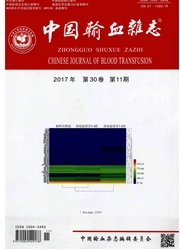

 中文摘要:
中文摘要:
目的分析广州地区HBV DNA^+/HBsAg^-献血者HBV基因型和S区"a"决定簇及主要亲水区(MHR)分子生物学特征,为进一步阐明OBI的分子机制提供参考。方法采用两种ELISA试剂和单人份核酸检测(NAT)平行检测的方法对广州市2013年10月至2014年5月无偿献血者血液标本进行筛查,采用巢式PCR对筛查出的HBV DNA^+/HBsAg^-标本S区进行扩增,扩增成功作为实验组。随机选取13例HBV DNA+/HBsAg+献血者标本作为对照组。对两组标本进行基因分型,分析"a"决定簇和主要亲水区(MHR)的置换位点和置换率。结果对筛查到的60例HBV DNA^+/HBsAg^-标本S区进行巢式PCR扩增,有19例扩增成功,两组在基因型分布方面没有统计学差异。实验组MHR区氨基酸序列置换率高于对照组(P〈0.05),两组在"a"决定簇氨基酸置换率没有统计学差异。19例实验组中变异比较多的位点为T126和Q129,分别为6和7次。实验组21号标本MHR出现6次变异,是置换率最高的一例。各组均未发现有基因缺失情况。结论 HBV DNA^+/HBsAg^-献血者S基因MHR存在较大变异,MHR变异对OBI的影响可能大于"a"决定簇,T126和Q129变异可能成为现有引起OBI新的高突变率点。
 英文摘要:
英文摘要:
Objective To analyze the genotypes and the molecular biological characteristics of S region among HBV DNA^+/HBsAg^- blood donors in Guangzhou, and to illuminate the molecular mechanisms of OBI. Methods HBV DNA^+/HBsAg^- samples were confirmed by ELISA and nucleic acid testing (NAT) among blood donors in Guangzhou between October 2013 and May 2014, and the S region of HBV DNA^+/HBsAg^- was amplified by nested PCR. Amplified samples were used as experimental group, 13 HBV DNA^+/HBsAg^- samples were randomly selected as control group, the two groups were contrasted in genotype, substitution site and substitutions ratio in "a" region and the main determinants hydrophilic region (MHR). Results 19 in 60 HBV DNA^+/HBsAg^- samples were amplified S region successfully by nested PCR. There were no statistically significant differences between the two groups in genotype distribution. Substitutions of MHR protein sequence were more frequent (P〈0.05) in the experimental group than in the control group, without statistically significant difference between the two groups in "a" region. The frequent amino acid substitutions sites were T126 and Q129, respectively 6 times and 7 times. NO.21 sample in the experimental group had the highest substitution ratio which had 6 mutation in MHR. Each group had no gene deletion. Conclusions The substitution rate is higher in MI-IR among the HBV DNA^+/HBsAg^- donors, and the mutations in MHR may have greater signification than "a" region to OBI. T126 and Ql29 mutation can become new and important OBI targets.
 同期刊论文项目
同期刊论文项目
 同项目期刊论文
同项目期刊论文
 期刊信息
期刊信息
